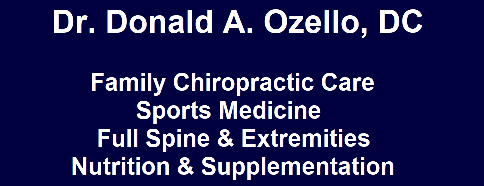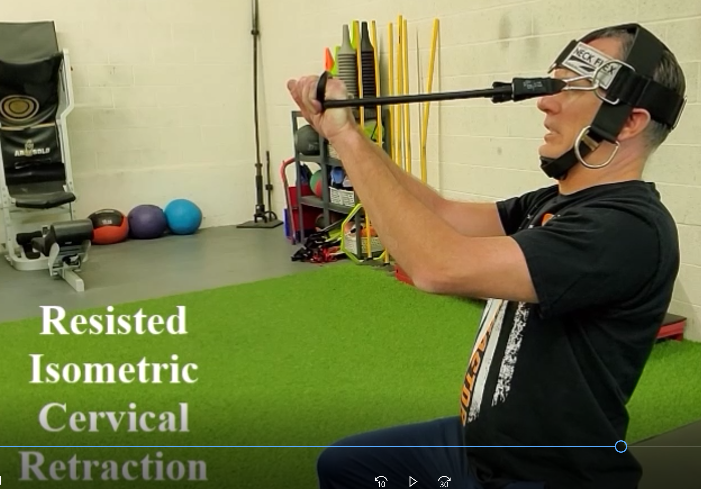Neck Pain (Chapter 27 of Running: Maximize Performance & Minimize Injuries by Dr Donald A Ozello DC)
Prevent neck pain while running to increase performance. Incorporate several simple guidelines to prevent the occurrence or worsening of neck pain when running. Injury prevention is easier, faster and less expensive than injury rehabilitation. Neck pain is more than just a nuisance when running. Neck symptoms and discomfort limit running performance. Neck pain negatively impacts upper body motions while running. A healthy neck is vital in all sports, including running.
Anatomy: In medical terminology the neck is named the cervical spine. The neck contains seven articulating vertebra.
Intervertebral discs (IVD) occupy the space between all the individual cervical vertebra, except between the skull and the first vertebra and between the first vertebra and the second cervical vertebra. Intervertebral discs possess a hard outer lining and a gel-like nucleus. The intervertebral disc functions to distribute shock throughout the vertebra. Direct blood flow to the intervertebral disc stops around the age of six. Following the cessation of direct blood flow the disc receives its nutrients through osmosis from the vertebrae located directly above and below it.
The spinal cord travels vertically through the spinal column. Spinal nerve roots branch off the spinal cord in between each vertebra. Branches of cervical nerve roots transmit signals to the neck, shoulders and upper extremities. Impingement on a spinal nerve root in the cervical spine may lead to symptoms throughout the entire course of the nerve. Many severe neck injuries involve the intervertebral disc impinging on the spinal nerve roots.
Neck muscles connect the cervical vertebrae, sternum, collar bones and shoulder blades to the skull or to other vertebrae. They function to move and support the head. Neck muscles also function as accessory breathing muscles. Tendons are strong bands of fibrous connective tissue that attach the muscles to bones. Tough structures called ligaments attach bones to each other to provide support and stability to joints.
Before Running: Conduct a thorough warm-up that includes the neck, upper back and shoulders. A comprehensive warm-up prepares your neck and upper back for running. Incorporate dynamic motions through a pain-free range of motion.
Dynamic Motions: The movements should be slow and controlled. Move the neck in all directions. Include bending the neck forward, backward, right and left. Turn the neck right and left. Slide the neck forward and retract your neck straight backward. Roll your neck in each direction two or three times. Perform several shoulder shrugs, shoulder rotations, arm circles and scapular retractions to prepare the upper back and shoulders. Attempt to work out the kinks and loosen the entire neck, upper back and shoulder area.
While Running: Several key factors reduce the possibility of running-related neck injuries; spinal posture, good shoulder posture, correct hand positioning, proper breathing and jaw relaxation.
Spinal Posture: Maintain an upright spinal position and keep your head in line with your spine. Hold your spine and neck in good posture throughout your run. Never hunch forward while running. A forward hunching posture places excess demand on the lower back, middle back, ribcage and diaphragm. When the middle and lower sections of the spine are in good posture, it is easier to maintain good neck posture.
Maintain your neck in line with your spine. Never hold your head jutted forward or bent downward. Forward head carriage places increased workload on the neck and upper back. Increased workload results in fatigue, pain and symptoms. Bending the neck forward for an extended amount of time increases pressure on the vertebrae and muscles. The spine is the nucleus of movement. Maintaining proper spinal and neck posture is imperative to lessening the possibility of acquiring running related neck pain.
Shoulder Posture: Keep your shoulders relaxed and in a neutral position. Never shrug your shoulders while running. Shrugging your shoulders tenses the neck and upper back muscles. Prolonged neck muscle tension is a precursor to pain and stiffness.
Move your shoulders and arms in a natural state. Not moving your shoulders and holding your arms hanging straight down pulls on the neck and upper back muscles. Continuous pull on the neck and upper back muscles leads to muscle tightness, discomfort and pain.
Maintain good shoulder posture by keeping your shoulders in line with your spine and neck. Don’t let your shoulders roll forward and downward. Holding your shoulders in a neutral position means the shoulders are in line with the spine and neck. In this position, they are not rolled forward or retracted too far backward.
Correct Hand Positioning: Keep your hands held loosely. Position your hands with the tips of your thumbs lightly contacting the tips of your middle fingers. Don’t clench your fists. Fist clenching creates tension throughout the entire upper body including the neck and upper back. Relaxed hands allow freer and natural arm, shoulder and neck movement.
Proper Breathing: Proper breathing while running lessens stress on the neck and upper back muscles. Proper breathing requires inhalation through the nose and exhalation through the mouth.
Labored breathing is a necessity during and after running hard or sprinting. Oxygen debt forces the body to breath deeper to supply the working muscles with additional oxygen. Excessive deep breathing when not necessary overworks the neck and upper back muscles. Several of the neck muscles are accessory breathing muscles. Accessory breathing muscles attach to the ribcage, sternum or clavicles. They contract to raise and/or expand the ribcage during deep breathing. Repetitive contraction of the accessory breathing muscles in the neck and upper back leads to fatigue, spam and pain.
Jaw Relaxation: Hold your jaw in a naturally relaxed position while running. Never clench your teeth or continually bite down when running. Teeth clenching increases pressure in the jaw, head and neck muscles. Prolonged clenching leads to painful jaw, neck and head symptoms.
After Running: Keep moving immediately following your run. Perform dynamic motion for three to five minutes, and then execute several static stretches. Give your body time to transition from an intense exercise state to a non-exercise state.
Static Stretching: Static stretches increase flexibility and decrease tightness. Stretching is not a flexibility contest and should never elicit symptoms. Exhale and move slowly into a comfortable stretch. Hold a gentle neck stretch between ten to twenty seconds. Stretch your neck toward your chest, to both sides and between straight forward and directly to the side.
A great time to massage and stretch the neck muscles is during your post workout shower. Let the hot water directly hit your neck and upper back to increase blood flow to the muscles. Gently massage the neck muscles to lessen tension. Execute static stretches in all ranges of motion after self-massage to further decrease muscle tension.
Professional Treatment: Receive consistent chiropractic treatment to develop and maintain neck health. Proper mobility and nerve flow established through regular chiropractic visits will help build and sustain a strong and flexible neck.
Conclusion: Neck pain and symptoms are bothersome and performance-limiting in all sports. Prevention is the best medicine. Build a healthier neck to increase athletic performance and lower the possibility of acquiring pain. Spend a few extra minutes before and after running to improve the health of your neck. Use correct posture, proper breathing and good hand positioning while running to lessen unnecessary demand on the neck. Enjoy your runs, get healthier and combat running-related neck pain by implementing these proven suggestions.
Dr Donald A Ozello DC of Championship Chiropractic in Las Vegas, NV
Web Site: http://www.championshipchiropractic.com/
Blog: https://www.championshipchiropractic.com/wordpress/
YouTube: https://www.youtube.com/user/drdozellodc/videos
Twitter: https://twitter.com/drdozellodc
Facebook: https://www.facebook.com/Championship-Chiropractic-280141628688300/
LinkedIn: https://www.linkedin.com/in/dr-donald-a-ozello-dc-716b3233
“Running: Maximize Performance & Minimize Injuries” https://www.amazon.com/Running-Performance-Chiropractors-Minimizing-Potential/dp/1493618741
**Disclaimer: Always consult a medical professional before beginning an exercise program. Always work within your capabilities. Never perform an exercise that elicits or increases pain or symptoms. Reading this article and viewing the linked videos does not take the place of seeing a medical professional. Please visit a medical professional for evaluation, diagnosis & treatment.

